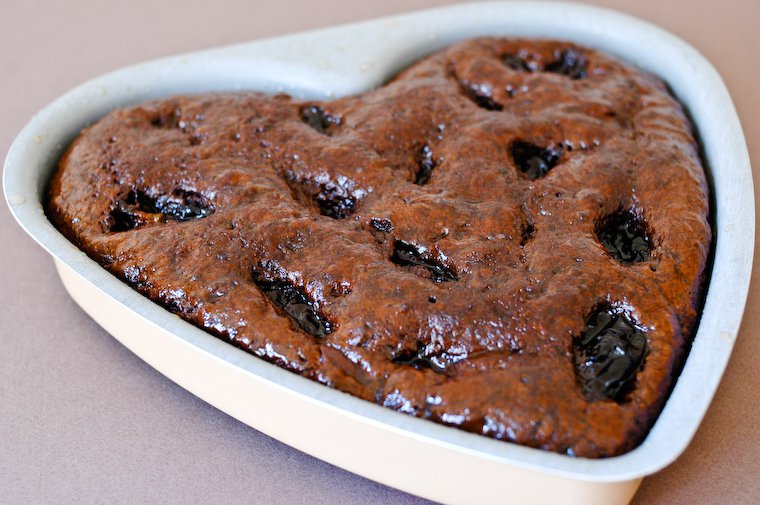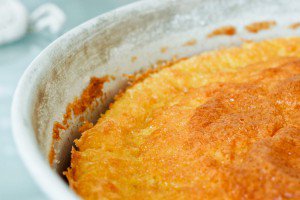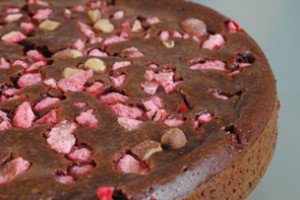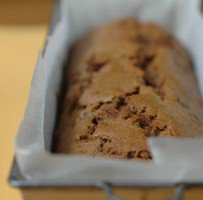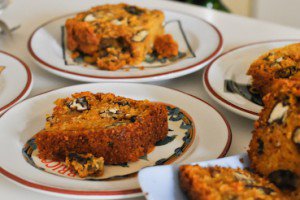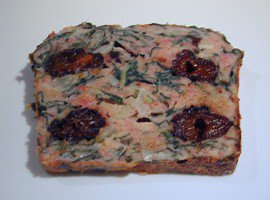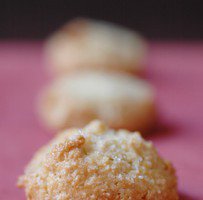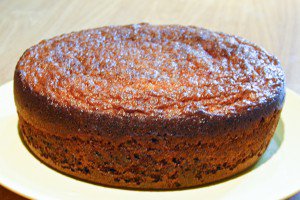Last time I was in London, my primary objective may have been to snuggle up with my nephew, but I still brought a list of food places I wanted to check out, for, you know, research purposes. One of them was Ottolenghi, a deli that offers a daily selection of colorful dishes — with an emphasis on fresh produce — and dazzling pastries.
I had received a review copy of their seductive cookbook a couple of months before, and had quickly stopped tagging the recipes that appealed to me when I realized I was placing a sticker on every page. This was my kind of food, and I was eager to taste it at the source.
After baking, the cake is further stickified by a generous brushing of brandy syrup, and left to cool. This produces a voluptuous cake that is moist-crumbed and deeply aromatic (but not at all boozy).
I visited the Kensington location (now closed), which happens to be around the block from the large Whole Foods store that was also on my list. I ogled the spectacular lineup of cakes, but decided instead on an assortment of salads to eat on the Eurostar that evening.
They were delicious, though it dawned on me halfway through that the reason why these salads seemed so pleasing was that most of them were pretty sweet, incorporating dried fruits or candied nuts or a sweetish dressing. Is it always so, or was it just an oddity on that particular day? A repeat visit is in order to find out, but I thought I’d keep that penchant in mind for when I tried savory recipes from the book.
As it turns out, the recipe I tried first was for a cake — and now that I think about it, I reduced the amount of sugar in that one, too. The recipe in question is the sticky chocolate loaf on page 219: it tugged at the strings of my heart because of the happy qualifier “sticky” — always a good omen when attached to a cake name — and because it was a chocolate cake that involved prunes, which I am fond of, and always keen to rehabilitate.
I made a few further modifications to the recipe, baking it in a cake pan rather than two mini loaf pans, substituting yogurt for the oil (the original called for yogurt and oil; I used yogurt only), and using maple syrup rather than treacle.
I hope the apparent length of the recipe below won’t scare you off; this is not a complicated cake to assemble at all. Half of the prunes are blended into the batter, in which they act as a sweetener and moisture booster, while the other half is soaked in brandy and pressed into the batter. After baking, the cake is further stickified by a generous brushing of brandy syrup, and left to cool. This produces a voluptuous cake that is moist-crumbed and deeply aromatic (but not at all boozy), and one I plan to make again soon, possibly in cupcake form.
~~~
If you’d like to read more about Ottolenghi, check their blog, which features some recipes, and read Yotam Ottolenghi’s weekly column in the Guardian, The New Vegetarian.

Have you tried this? Share your pics on Instagram!
Please tag your pictures with #cnzrecipes. I'll share my favorites!
Ingredients
- 220 grams (8 ounces) plump dried prunes (about 16 medium), pitted
- 80 ml (1/3 cup) brandy* such as Cognac, Armagnac, or other brandy (see note)
- 120 ml (1/2 cup) plain yogurt or buttermilk (the original recipe calls for half buttermilk, half sunflower oil)
- 1 egg, lightly beaten
- 75 grams (6 tablespoons) unrefined light brown cane sugar
- 3 tablespoons maple syrup or treacle
- 120 grams (1 cup) flour
- 1/2 teaspoon baking powder
- 1/2 teaspoon baking soda
- 1/4 teaspoon sea salt
- 3 tablespoons unsweetened cocoa powder
- 150 grams (5 1/3 ounces) bittersweet chocolate, roughly chopped
- 50 grams (1/4 cup) unrefined light brown cane sugar
Instructions
- Preheat the oven to 180° C (360° F), grease the sides of a small cake pan (about 1 liter or 4 cups in capacity) and line the bottom with parchment paper. (The original recipe calls for two 500g/2-cup loaf pans; muffin tins would work well, too.)
- Place half of the prunes and the brandy in a small saucepan and heat over low heat until just slightly warm. Set aside to plump up.
- Put the remaining prunes and the buttermilk in a blender or mini-chopper, and process until smooth. (If the lid of your mini-chopper is not 100% watertight, blend the prunes with just enough buttermilk to moisten, otherwise the excess liquids will leak out, and this is v. annoying.)
- Pour into a large mixing bowl. Whisk in the egg, sugar, and maple syrup, beating well between each addition.
- In a medium mixing bowl, place the flour, baking powder and soda, salt, and cocoa powder. Stir with a whisk to combine and break any lump.
- Fish the prunes from the brandy (reserve the brandy) and cut in halves with kitchen shears. Set aside.
- Add the dry ingredients to the wet ingredients and mix until just combined; don't overmix. Fold in the chopped chocolate. Pour the batter into the prepared pan, level the surface, and top with the prune halves, pressing them down gently so they're half engulfed in the batter.
- Bake for 30 minutes (40 minutes for loaves, 15-20 for muffins), until set. A cake tester inserted in the center should come out clean (but don't mistake a melted chocolate chunk for raw batter).
- While the cake is baking, prepare the syrup: add the 50 grams (1/4 cup) sugar and 80 ml (1/3 cup) water to the brandy in the pan. Bring to a simmer over medium heat, and remove from heat immediately.
- When the cake comes out of the oven, pierce a few holes through it with a skewer and brush with the warm syrup with a pastry brush, until saturated. Let cool completely before unmolding.
Notes
- Adapted from Ottolenghi: The Cookbook.
- If you can't or won't have liquor in your cake, you can replace the brandy with good black tea.


